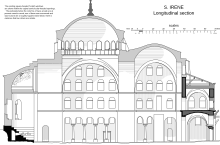Hagia Irene
The Hagia Irene or Hagia Eirene ( Greek Αγία Ειρήνη "Church of Divine Peace", Turkish Aya İrini ; also Irish Church ) is a Byzantine church in Constantinople . In the Ottoman period it was used as an arsenal, today it is a museum and serves as a concert hall.
location
Hagia Irene is located in the large (first) courtyard between Hagia Sophia and Topkapı Palace in Istanbul .
history
The Irenenkirche was built under the Roman Emperor Constantine I in the 4th century as the first church in Constantinople. It was a scene of the - sometimes bloody - clashes between Arians and Trinitarians during the Arian dispute . In 381 the Second Ecumenical Council met in Hagia Irene, which was supposed to end this dispute. It was the Church of the Patriarchate before Hagia Sophia was built.
After the church was burned down in 532 during the Nika uprising , Justinian I had it rebuilt. After being destroyed again by an earthquake in 740, Hagia Irene was largely rebuilt under Constantine V.
After the conquest of Constantinople by the Ottomans in 1453, the palace guard of the Janissaries used the church as an arsenal . Ahmet Fethi Pascha , Marshal of the Arsenal, had a museum set up in the church in 1846. When in 1875 there was no longer enough space for further exhibits, the collection was moved to the Çinili Köşk in the Topkapı palace complex. In 1869 the church became the Reich Museum (Müze-i Hümayun) and in 1908 a military museum for some time. The restored monument has been used for classical concerts since 1973 because of its impressive acoustic atmosphere, but as a museum it is under the control of the Hagia Sophia Museum Directorate. Most of the concerts of the Istanbul Music Festival have been held in Hagia Irene since 1980.
description
Hagia Irene is an early example of the transition from the basilical floor plan to the central building in the form of a Greek cross . In its present form, the building dates from the 8th century. Hagia Irene is the only Byzantine church with an originally preserved atrium .
The gallery basilica , vaulted by two domes, ends in the east in a polygonal apse pierced by three large arched windows . In the apse calotte there is no representation of the Theotokos , but a large cross. It is a unique testimony to iconoclastic art. A comparable representation can be found in the apse dome of Sant'Apollinare in Classe . There the cross symbolizes Christ in the context of the transfiguration .
literature
- Muzaffer Ramazanoğlu: New research on the architectural history of the Irenenkirche and the complex of the Sophienkirche. In: Atti del VIII congresso di studi bizantini 2, Studi byzantini e neoellenici, Palermo 1951, pp. 332-335.
- Peter Grossman : To the atrium of the Irish Church in Istanbul . In: Istanbuler Mitteilungen 15, 1965, pp. 186-237.
- Urs Peschlow : The Irish Church in Istanbul. Research on architecture. Tuebingen 1977.
- Urs Peschlow: A new look at the building history of the Irenenkirche in Istanbul. In: Cecil Lee Striker (Ed.): Architectural Studies in Memory of Richard Krautheimer . Mainz, Zabern 1996, pp. 133-136.
Web links
Individual evidence
- ↑ Hagia Irene. In: arch INFORM ; Retrieved December 1, 2009.
Coordinates: 41 ° 0 ′ 35 ″ N , 28 ° 58 ′ 52 ″ E




